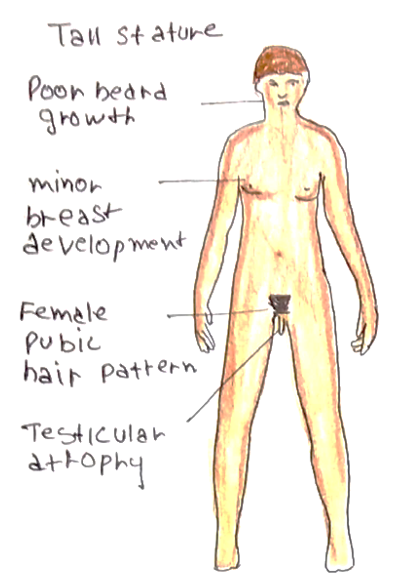Klinefelter’s Syndrome
This is a condition which leads to an additional sex chromosome, giving the karyotype 47 XXY
– The offspring will be male due to the presence of the Y chromosome but will have deformities
Inheritance:
Extra X chromosome due to nondisjunction during male or female meiosis
Symptoms:
– Body –> Tall stature
– Head and Neck –> Poor beard growth
– Feminisation of body –> Gynaecomastia (increasing risk of breast cancer), less body hair, less muscle mass
– Genitals –> Small poorly functioning testicles, lack of libido
– Endocrine –> lack of secondary sexual characteristics, giving infertility
Diagnosis:
– Chromosomal analysis (karyotyping)
– Blood tests show high FSH and LH but low testosterone

Management:
– Testosterone replacement hormone therapy
– Infertility treatment (e.g., ICSI or IVF) used to help them produce offspring
– Breast removal surgery due to risk of breast cancer
Turner’s Syndrome
This is a condition which leads to a missing chromosome, giving the karyotype 45XO
– As there is no Y chromosome, these individuals are female and with have female sexual organs
Inheritance:
Either due to presence of only one sex chromosome (X) or deletion of the short arm of one of the X chromosomes
Symptoms:
– Antenatal –> Early miscarriage, foetal hydrops and cystic hygroma
– Body –> Short stature and many pigmented naevi
– Head and Neck –> Webbed neck, high-arched palate
– Chest –> Widely spaced nipples, shielded chest
– Limbs –> spoon-shaped nails, lymphoedema
– Heart –> bicuspid aortic valve, aortic coarctation
– Ovaries anomalies –> ovarian dysgenesis giving amenorrhea in puberty

Complications:
– Endocrine –> primary amenorrhoea, hypothyroidism
– Autoimmune –> increases risk of Crohn’s disease
– Infertility (due to ovarian dysgenesis)
Diagnosis:
– Can be diagnosed karyotyping antenatally (by amniocentesis or CVS) or postnatally
Management:
No cure available, management focussed on treating the symptoms
– Growth hormone replacement
– Oestrogen replacement (for the development of secondary sexual characteristics)
Swyer Syndrome
This is a rarer condition in which there is a mutation in the SRY gene on the Y chromosome.
– This gene is needed for the masculinisation of the embryo. Without it, the indifferent gonads fail to differentiate into testicles in an XY fetus
– As such, this means that these XY individuals develop as females with a uterus, fallopian tubes, vagina etc.
– Therefore, people with Swyer syndrome are born with the normal appearance of female, but they have non-functional gonads.
– This leads to problems in puberty as the gonads will not make oestrogen, so they do not have breast growth and menstrual periods
Management:
Oestrogen and Progestogen hormone replacement therapy
Noonan syndrome
This is a condition which is referred to as the male version of Turner’s syndrome. However, unlike Turner’s syndrome the mutation is not on one of the sex chromosomes – instead it is an autosomal dominant condition
Inheritance:
An autosomal dominant condition due to mutation in gene (usually PTPN11) on Chr 12
Symptoms:
– Head and neck –> Low-set ears, triangle shaped face, large head with excess skin on back of neck
– Eyes –> Hypertelorism (widely spaced eyes)
– Skin –> lymphedema
– Body –> webbed neck, short, wide space between the nipples (resembling Turner syndrome)
– Heart abnormalities –> Pulmonary valve stenosis

Management:
MDT approach to manage symptoms according to system affected

